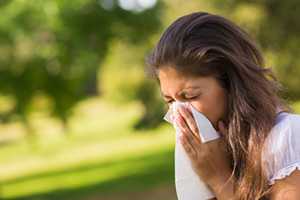Allergens
 Climate change, resulting in more frost-free days and warmer seasonal air temperatures, can contribute to shifts in flowering time and pollen initiation from allergenic plant species. Increased CO2 by itself can elevate production of plant-based allergens. Higher pollen concentrations and longer pollen seasons can increase allergic sensitizations and asthma episodes and diminish productive work and school days. Simultaneous exposure to toxic air pollutants can worsen allergic responses. Extreme rainfall and rising temperatures can also contribute to indoor air quality problems, including the growth of indoor fungi and molds, with increases in respiratory and asthma-related conditions.
Climate change, resulting in more frost-free days and warmer seasonal air temperatures, can contribute to shifts in flowering time and pollen initiation from allergenic plant species. Increased CO2 by itself can elevate production of plant-based allergens. Higher pollen concentrations and longer pollen seasons can increase allergic sensitizations and asthma episodes and diminish productive work and school days. Simultaneous exposure to toxic air pollutants can worsen allergic responses. Extreme rainfall and rising temperatures can also contribute to indoor air quality problems, including the growth of indoor fungi and molds, with increases in respiratory and asthma-related conditions.
Asthma prevalence (the percentage of people who have ever been diagnosed with asthma and still have asthma) increased in the U.S. from 7.3% in 2001 to 8.4% in 2010. Asthma visits in primary care settings, emergency room visits, and hospitalizations were all stable from 2001 through 2009. Asthma death rates per 1,000 persons with asthma declined from 2001 through 2009. As pollen exposures increase, patients and their physicians will face increased challenges in maintaining adequate asthma control.
- Page last reviewed: December 11, 2014
- Page last updated: December 11, 2014
- Content source:


 ShareCompartir
ShareCompartir